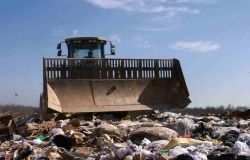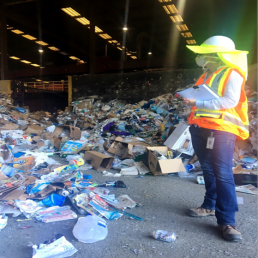Solid Waste Facility Required Permits

Landfill Operation Permits
There are several major permits required to operate any landfill including the following:
1. Solid Waste Facility Permit
In terms of the Solid Waste Facility Permit, the facility's "operation" includes: procedures, personnel, and equipment utilized to receive, handle, and dispose of solid wastes and to control the effects of the facility on the environment.
- The landfill operator is required to obtain a Solid Waste Facility Permit from the Local Enforcement Agency (LEA) under the authority of the Public Resources Code (Sections 44001-44018) and California Code of Regulations (CCR) Title 27, Division 2, Subdivision 1, Chapter 4 (beginning at Section 21440). The Solid Waste Facility Permit is issued by the LEA with concurrence from the The Department of Resources Recycling and Recovery (CalRecycle) formerly the California Integrated Waste Management Board (CIWMB). The Solid Waste Facility Permit specifies the person(s) authorized to operate the facility and the boundaries of the facility. The Solid Waste Facility Permit contains the conditions necessary to specify a design and operation for which the applicant has demonstrated to the LEA the ability to control the adverse effects of the facility. In terms of the Solid Waste Facility Permit, the facility's "design" includes:
- the number and types of fixed structures;
- the total volumetric capacity of the disposal site;
- vehicle traffic flow and patterns surrounding and within the facility;
- proposed contouring; and
- other factors that may be considered a part of the facility's physical configuration.
2. Waste Discharge Requirements
Landfill operators are required to obtain Waste Discharge Requirements from the Regional Water Quality Control Board (in this case the San Diego RWQCB Region 9) in accordance with CCR Title 27, Division 2, Subdivision 1, Chapters 4 (beginning at Section 21710). The Waste Discharge Requirements detail the types of wastes acceptable for disposal at the proposed landfill. The Waste Discharge Requirements also condition the design and operation of the landfill, as well as establishing water quality monitoring and reporting requirements to evaluate the effectiveness of the waste containment features.
3. (Stormwater) National Pollution Discharge Elimination System (NPDES) Permit
The San Diego Regional Water Quality Control Board (RWQCB Region 9) also regulates stormwater discharges related to industrial activities. The landfill operator is required to comply with the General Permit to Discharge Stormwater Associated with Industrial Activity. This permit requires the landfill operator to develop and implement a Stormwater Pollution Prevention Plan (SWPPP) and a Stormwater Monitoring Program (SWMP).
4. Permit to Construct/Permit to Operate
The San Diego Air Pollution Control District (APCD) regulates dust and landfill gas emission from landfill operating in San Diego County. The permits required to build and operate a landfill gas flare station to collect and destroy landfill gas are issued in two phases. The first phase concerns the design and construction of the landfill gas collection system and flare station. The design and construction of the system is authorized by the APCD through a Permit to Construct. The second phase concerns the actual operation of the landfill gas collection system and flare station, and is authorized by a Permit to Operate.
Landfill Development Permits
The development of a landfill often requires several other permits. These additional permits are needed to allow construction of the facility and its features. Some of these include:
- Section 404 Permit from the US Army Corps of Engineers to address disturbance to "waters of the United States;"
- Section 7 Consultation from the US Fish and Wildlife Service to address Endangered Species issues;
- Streambed Alteration Agreement (Section 1603) from the California Department of Fish and Game to address disturbances to natural streambeds;
- Section 106 Consultation from the Advisory Council on Historic Preservation to address cultural resource issues;
- Encroachment Permit from the California Department of Transportation (Caltrans) for modifications to transportation routes;
- Encroachment Permit from the San Diego County Water Authority to cross the Authority's First San Diego Aqueduct easement containing its water delivery pipelines;
- Various County of San Diego permits related to grading, construction, and building, etc.


